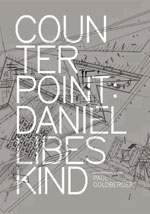|
|
When the last monograph surveying Daniel Libeskind’s work was published—some eight years ago—the New York architect was riding a wave of praise for his Jewish Museum in Berlin. The project had won him international renown, putting him in league with other architects at the top of the profession. But at the time, the museum was one of his few built works.
Since then, Libeskind has realized half a dozen more museum projects, as well as single and multi-family residences, commercial spaces, and even a shopping mall. His formally ambitious work has made him a favorite of clients looking for recognizable design. From critics, it has drawn a mix of admiration and vitriol that has placed him at the center of debates about the values and aesthetics of architecture in the first decade of the 21st century.
Counterpoint: Daniel Libeskind, a new volume published by Monacelli Press, carries the last monograph forward, chronicling 36 projects—15 built, 12 currently under construction, and 9 unbuilt. The work ranges from his early Felix Nussbaum Haus to a recently announced residential tower for Manhattan.
Like the shimmering crags of his Denver Art Museum jutting through the cityscape, the book does not sit demurely on the coffee table. Bound in a reflective silver cover, it spells out a design philosophy in large type over roughly 400 pages.
Structured as a dialogue with critic Paul Goldberger—an extended conversation forms the introduction—the book prefaces each project with a left hand page, where questions about the work posed in a small font are answered with brief responses in big, angular letters. Each project then unfolds in a series of photographs, renderings, and plans.
I recently spoke with Libeskind about the monograph. Frenetic, but also reflective, he discussed similarities among the projects detailed in the book as well as the state of architecture at the time of its release.
William Hanley: Why did you structure the monograph as a dialogue?
Daniel Libeskind: Well, you know, monographs are really a bore, and I wanted something more interactive. It’s about a conversation. I’ve always considered architecture itself a means of communicating.
I also wanted to create a book that was very clear. It isn’t just a bunch of blurred Xeroxes and computer graphics—computer noise—which are very popular.
WH: What is contrapuntal about your work?
DL: I don’t work in a linear manner. I don’t start from A and go to B.
WH: As the book took shape, were you surprised by anything as you revisited your body of work?
DL: Inevitably. For example, it occurred to me that the shopping center in Switzerland has a lot of cultural ideas. It looks more like a museum than a shopping center. It tends to transform the idea that architecture is just an elitist thing for a particular civic benefit. All architecture is civic, and even if you do a private house, it’s all part of some public realm.
I also realized that there is a continuity in my work that goes beyond the programmatics of different projects. I didn’t calculate it, but when you look at the book, a certain kind of exuberance arises.
My New York: Daniel Libeskind recently toured two of his favorite New York buildings with RECORD.
WH: Introducing the Imperial War Museum in Manchester, England, you address a question about the “familial relationship” among your projects, saying, “The true signature of a building is not a fashion or a style, but a character that resists appropriation.”
DL: Quite frankly nobody will copy the Jewish Museum. Nobody will copy the Denver Art Museum because they can’t. They are truly inventions that require a lot of commitment.
The signature is something authentic. It’s not something done just for commerce. It’s about research. It’s about belief, passion, intensity. It’s something that is the art of architecture.
WH: Some of the buildings in this monograph have come to characterize an era of large, highly visible projects that may disappear in the current economic climate. Do you think we will see fewer buildings with the scale of, say, the Denver Art Museum in a few years?
DL: I think that people will be more conscious and not build as much, but then it’s even more important—and I think clients are very savvy [about this] today—to invest in something that is value for money. I think it’s not a coincidence that the Empire State Building got built in a difficult economic era.
WH: Do you think we will emerge from this recession with a changed sense of social or aesthetic priorities in architecture? Will constraint—to some extent—foster creativity?
DL: I think that constraint is something that I’ve always had and I’ve always admired. What would a poet do without rhyme and sound?
You have to pursue architecture whatever the external conditions are. Even if you can’t build it, you draw it, you investigate it. I think the great architects have always worked, whether they had jobs or not.




Post a comment to this article
Report Abusive Comment